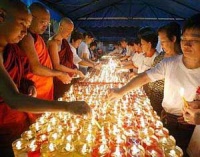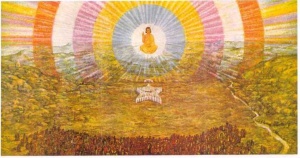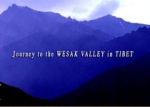Wesak
Wesak (Pali: Vesākha; Sanskrit: Vaiśākha वैशाख) is the most important of the Buddhist festivals and it is usually celebrated on the full moon in May (though the date may vary according to the various lunar calendars used in different traditions). This holy day, observed by Buddhists of the different schools, is sometimes informally called "Buddha's Birthday". However, it commemorates the birth, enlightenment, and death of Gautama Buddha.
Account by C. W. Leadbeater
According to C. W. Leadbeater, once in each year, on Wesak, Gautama Buddha sheds upon the physical plane a flood of blessing. He explained:
The Lord Buddha has His own special type of force, which He outpours when He gives His blessing to the world, and this benediction is a unique and very marvellous thing; for by His authority and position a Buddha has access to planes of nature which are altogether beyond our reach, hence He can transmute and draw down to our level the forces peculiar to those planes. Without this mediation of the Buddha these forces would be of no use to us here in physical life; their vibrations are so tremendous, so incredibly rapid, that they would pass through us unsensed at any level we can reach, and we should never even know of their existence. But as it is, the force of the blessing is scattered all over the world; and it instantly finds for itself channels through which it can pour (just as water instantly finds an open pipe), thereby strengthening all good work and bringing peace to the hearts of those who are able to receive it.[1]
He also stated that, at least up to the early 20th century, a ceremony was organized by the Masters of Wisdom during the full moon of Wesak at which the Buddha actually showed Himself "in the presence of a crowd of ordinary pilgrims". This ceremony took place in "a small plateau surrounded by low hills, which lies on the northern side of the Himalayas, not far from the frontier of Nepal, and perhaps about four hundred miles west of the city of Lhassa". He wrote:
Whether He shows Himself to pilgrims I am not certain; they all prostrate themselves at the moment when He appears, but that may be only in imitation of the prostration of the Adepts and Their pupils, who do see the Lord Gautama. It seems probable that some at least of the pilgrims have seen Him for themselves, for the existence of the ceremony is widely known among the Buddhists of central Asia, and it is spoken of as the appearance of the Shadow or Reflection of the Buddha, the description given of it in such traditional accounts being as a rule fairly accurate. So far as we can see there appears to be no reason why any person whatever who happens to be in the neighbourhood at the time may not be present at the ceremony; no apparent effort is made to restrict the number of spectators; though it is true that one hears stories of parties of pilgrims who have wandered for years without being able to find the spot.[2]
Later efforts to corroborate this account with Tibetan monks have been for the most part unsuccessful.
Col. Olcott and Wesak in Sri Lanka
In the 1880s the British colonial government of the traditionally Buddhist Ceylon (now Sri Lanka) recognized only the Christian holidays, and punished children who were absent from the missionary schools on their own religious holidays.
In May of 1884, as part of his work for the Buddhist revival, Col. H. S. Olcott went to London and sent a memo to colonial officials, among other things, "to try and secure an order declaring Wesak—the May Full-Moon day, Buddha's Birthday, and consequently the Buddhist Christmas—a public holiday".[3] On April 28, 1885, Wesak became an official holiday in British Ceylon.
Once the Buddhist holidays were recognized by the government, other religions quickly secured like recognition.
Online resources
Articles
- Wesak at Theosopedia
Books
- The Masters and the Path Chapter XIV, by C. W. Leadbeater
Video
- Falzon, Albert. Journey to the Wesak Valley in Tibet: A Film Journey on YouTube. This film was filmed in May 1985 by David Thomas, Hock Khoe, and Albert Falzon. The film was edited by Fil Baker and Albert Falzon, and the lovely music was created by Carlos Angeles and Lucinda Dreaming. See www.wesakfilm.com for the film and accompanying book.
- Mullin, Glenn. A Himalayan Vision Quest Vesak 2014 on YouTube.
Notes
- ↑ Charles Webster Leadbeater, The Masters and the Path, (Adyar, Madras: The Theosophical Publishing House, 1992), ??.
- ↑ Charles Webster Leadbeater, The Masters and the Path, (Adyar, Madras: The Theosophical Publishing House, 1992), ??.
- ↑ Henry Steel Olcott, Old Diary Leaves Third Series (Adyar, Madras: The Theosophical Publishing House, ???), 76.


